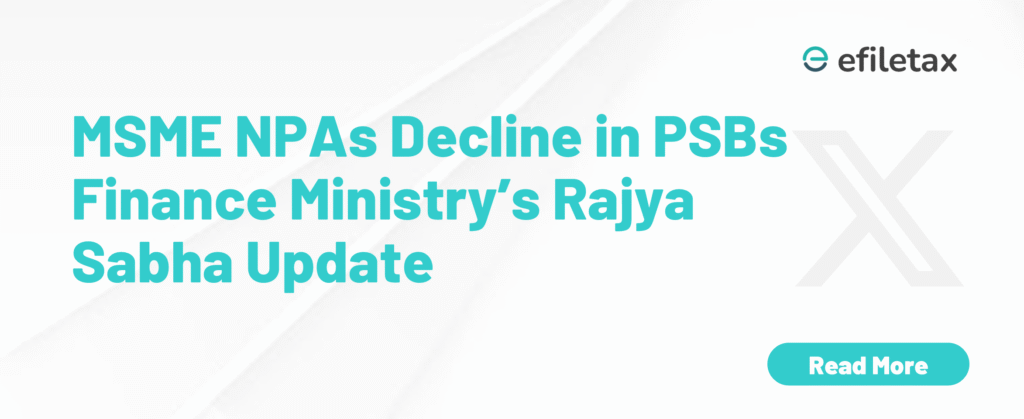
MSME Bad Loans Falling in Public Sector Banks
MSME bad loans in India’s public sector banks have seen a consistent decline over the past few years, according to data recently presented by the Finance Ministry in the Rajya Sabha. This is a positive signal for the economy, especially for the small business ecosystem, where credit stress had long been a concern.
What Did the Finance Ministry Say?
In a written reply to the Rajya Sabha (July 2025 session), the Ministry of Finance shared that:
- Gross NPA (Non-Performing Assets) in the MSME sector has declined in both absolute terms and as a percentage of total advances.
- This trend is visible across major public sector banks (PSBs).
- Improvements in loan restructuring schemes, credit monitoring, and MSME-specific initiatives have contributed to the fall.
Official Data Snapshot (Source: Rajya Sabha QA, Ministry of Finance)
| Financial Year | MSME NPA (₹ crore) | % of MSME Advances |
|---|---|---|
| 2021–22 | ₹1,77,660 crore | 9.3% |
| 2022–23 | ₹1,56,425 crore | 7.6% |
| 2023–24 | ₹1,38,970 crore | 6.2% |
Note: These figures are aggregate NPAs of public sector banks from MSME accounts.
Why Are MSME Bad Loans Declining?
Several policy-level and systemic changes have supported this improvement:
- ECLGS Scheme: The Emergency Credit Line Guarantee Scheme (ECLGS), launched during COVID, offered collateral-free credit to MSMEs.
- RBI’s Loan Recategorisation Framework: Allowed stressed MSMEs to restructure without downgrading accounts as NPAs.
- Digital Credit Monitoring: Banks now use digital tools to track MSME cash flows and repayment risks.
- PM Vishwakarma Yojana & Credit Outreach: Focused support to artisans and micro-enterprises helped reduce informal borrowing.
Compliance Tips for MSMEs to Avoid NPAs
If you’re an MSME borrower, these practical steps can help maintain a clean credit record:
- File GST and ITR on time: Banks often review your compliance history before granting loans.
- Opt for invoice financing: Avoid cash flow issues by discounting your receivables through NBFCs or PSB schemes.
- Use loan moratoriums wisely: Don’t over-rely on restructuring unless genuinely needed.
- Track your CIBIL MSME Rank: New MSME-specific credit scoring helps banks assess borrower risk.
Legal and Regulatory Background
The RBI’s Circular dated 6 August 2020, and later amendments, allowed one-time restructuring of MSME loans without downgrading the asset classification, under specified conditions.
The Budget 2023 and Budget 2024 reinforced MSME financing through revised credit guarantee fund allocations and expansion of formal loan access.
Further, PSB 59-minute loan portal and Udyam portal linkage have improved due diligence and automated eligibility checks, curbing wilful defaults.
Expert View: What MSMEs Must Watch Out For
“Compliance is now directly linked to creditworthiness. MSMEs must treat GST filing and ITR like balance sheet hygiene — delay it, and your funding options shrink drastically.”
— Tax Consultant at Efiletax
Conclusion: MSMEs Must Stay Ahead
The fall in MSME bad loans is encouraging, but maintaining this trend will require ongoing compliance, transparency, and financial discipline from businesses.
Need help filing your ITR or keeping your books clean for bank loans? Let Efiletax handle it — so you can focus on growth.
FAQs
Q1. What counts as a bad loan for MSMEs?
A loan where repayment is overdue beyond 90 days is treated as a non-performing asset (NPA).
Q2. Is MSME restructuring still available in 2025?
Only under specific RBI frameworks. General one-time restructuring ended, but sector-specific schemes may apply.
Q3. Can a GST defaulter get a business loan?
Most PSBs and NBFCs now check GST filing status before sanctioning loans. Non-filers are at a disadvantage.
Summary
MSME bad loans in PSBs have dropped from 9.3% to 6.2% in two years. Find out why, what it means for small businesses, and how to stay compliant.